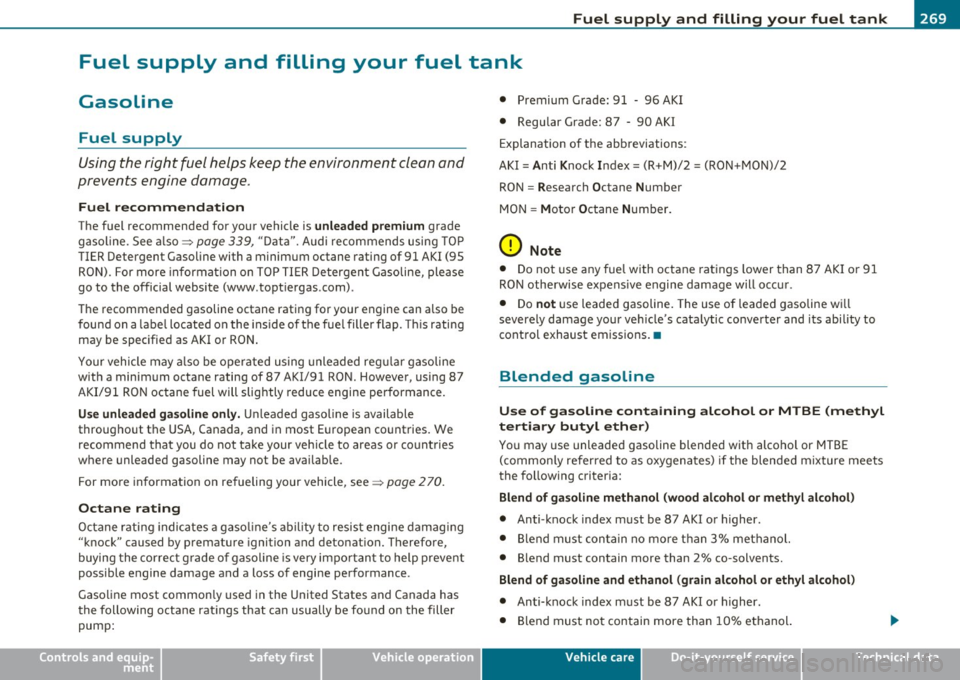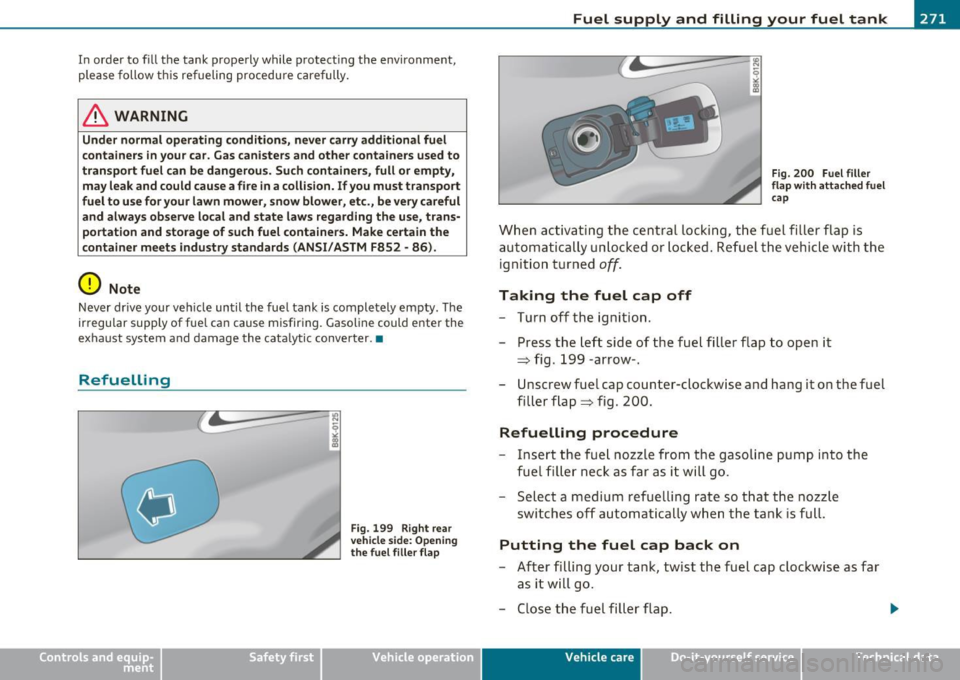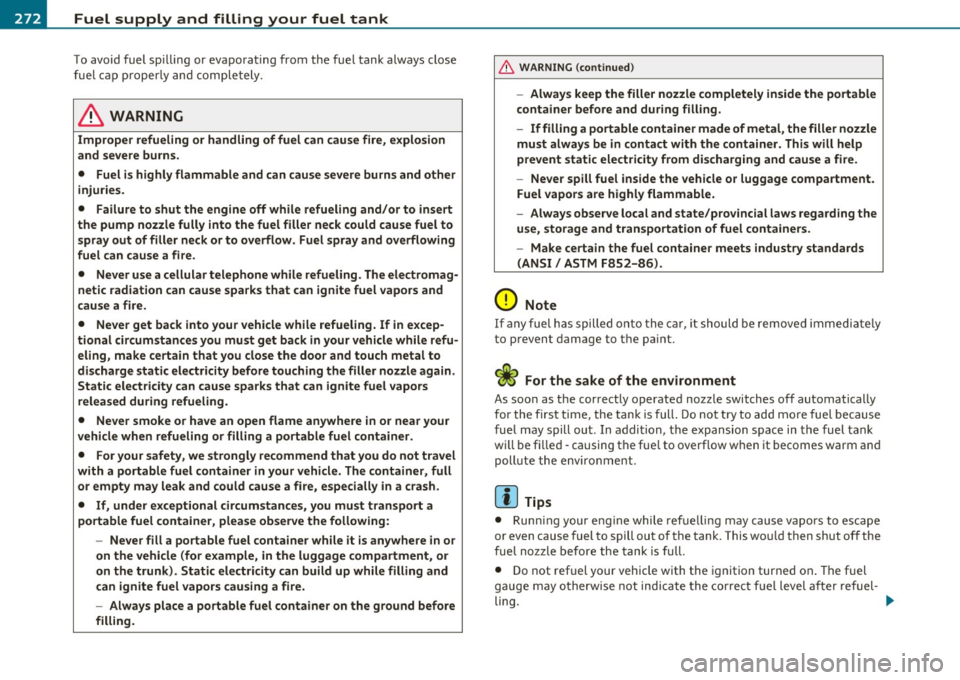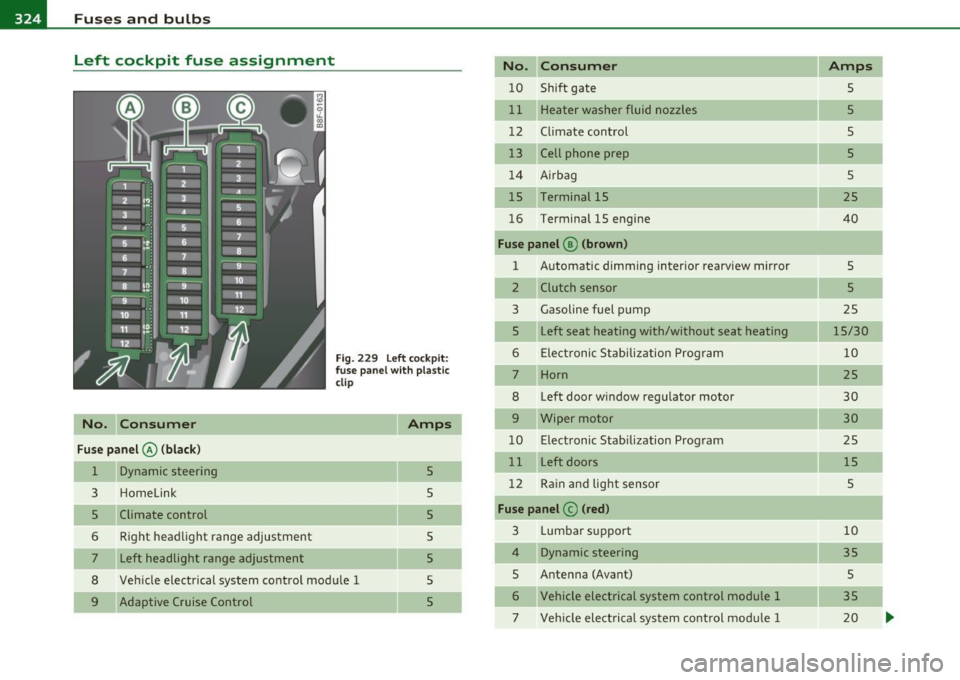fuel pump AUDI A5 COUPE 2011 Owners Manual
[x] Cancel search | Manufacturer: AUDI, Model Year: 2011, Model line: A5 COUPE, Model: AUDI A5 COUPE 2011Pages: 362, PDF Size: 84.88 MB
Page 27 of 362

Current fuel mileage
The instantaneous fuel consumption in miles per gallon (l/100 km) is
show n in this display . You can use this disp lay to adjust your driv ing
technique to achieve a desired mileage.
Fuel consumption is recalculated at intervals of 33 yards (30 meters).
Th is display switches to gallons/hour (liters/hour) when the vehicle is
not moving .
Average speed
The average speed in mph (km/h) since the last time the display was
reset appears in the display.
Elapsed time
The length of time that you have been driving since you last reset the
memory appears in this display.
Distance
The distance that has been covered since the last time the memory
was cleared appears in the display .
[I) Tips
• Fuel consumptions (average and current), range and speed are
displayed in metric units on Canadian models.
• All stored values will be lost if the vehicle battery is
disconnected .•
Controls and equip
ment Safety first
Driver information display
Memories
The trip computer is
equipped with two fully automatic
memories as well as an efficiency program*.
Fig . 16 Trip computer
display: memory level
1
You can switch between the trip computer 1 and 2 and the efficiency
program* by pressing the [
RESET] button @=> page 26, fig . 17 .
You can tell which memory level is currently active by the number or
the sign in the display => fig. 16. The data from the single-trip
memory (memory leve l 1) is being displayed if a
1 appears in the
display . If a
2 is shown, then the data from the total -trip memory is
being displayed (memory level 2). The fuel pump nozzle
ii indicates
the efficiency program*=>
page 27.
Single-trip memory (Trip computer 1)
The sing le-trip memory stores the trip information from the time the
ignition is turned on until it is turned off. If the trip is continued
within 2 hours from the time the ignition was turned off, the new
data will be included in the calculation of the current trip informa
tion.
If the trip is interrupted for more than 2 hours the memory is
reset automatically.
Total-tr ip memory (Trip computer 2)
Unlike the single-trip memory, the total-trip memory is not reset
automatically. This permits you to evaluate your driving data for the
entire pe riod between manual resets. _..
Vehicle care Technical data
Page 271 of 362

Fuel supply and filling your fuel tank
Fuel supply and filling your fuel tank
Gasoline
Fuel supply
Using the right fuel helps keep the environment clean and
prevents engine damage .
Fuel recommendation
The fuel recommended for your vehicle is unleaded premium grade
g asoline . See also :::>
page 339, "Da ta ". Aud i recommends using TO P
TIER Detergent Gasoline with a minimum octane ra ting of 91 AKI (95
R O N). For more information on TOP TIE R Detergen t Gasoline, please
go to the official website (www. toptiergas .com) .
Th e recommended gasoline octane ratin g for your engine can also be
found on a labe l located on the ins ide of t he fue l fille r flap. This rating
may be specified as AKI o r RON .
Your vehicle may also be ope rated us ing unleaded reg ular gasoline
with a minim um octane rating of 87 AKI/91 RON. However, us ing 87
AKI/91 RON octane fuel will slig htly reduce engine performance.
Use un leaded ga soline only. U nleaded gaso line is available
throughout the USA, Canada, and in most E uropean co untries. We
recommen d that you do not ta ke your veh icle to areas or co unt ries
where unleaded gasoline may not be available.
F or more in formation on re fueling yo ur vehicle, see:::>
page 270 .
Octane rating
Octane r ati ng indi cat es a gaso line's abi lity to resis t engi ne damag ing
"knock" caused by premature ignition and detonat ion. Therefore,
buying the correc t g rade o f gasol ine is very impo rtan t to help preve nt
possible engine damage and a loss of engine performance .
Gaso line most common ly used in the United States and Canada has
the following octa ne rat ings tha t ca n usually be fou nd on the filler
pump :
Safety first
• Premium Grade: 91 - 96 AKI
• Regular Grade: 87 - 90 AKI
E xplanation of t he abb reviations :
AKI= Anti Knock Index= (R +M)/ 2 = (RON+ MON)/2
RO N= Research Octane Number
M ON= M otor Octane Num ber.
0 Note
• Do not use a ny fue l with octane rat ings lower than 87 AKI o r 91
RO N otherwise expens ive engine damage will occ ur.
• Do
not use leaded gasoline. The use of lea ded gasoline w ill
severely damage your veh icle 's cata lytic converter and its abi lity to
cont rol exhaust emissions .•
Blended gasoline
Use of gasoline containing alcohol or MTBE (methyl
tertiary butyl ether)
Yo u may use unleaded gasoline blended w ith alcoho l or MTBE
( c ommon ly referred to as oxygenates) if the blended mix ture meets
the following criteria:
Blend of ga soline methanol (wood alcohol or methyl alcohol)
• Anti -k nock index m ust be 87 AKI or h igher .
• Bl end must con tain no mo re t han 3% methanol.
• Blend must contain more than 2% co-solvents.
Blend of ga soline and ethanol (grain alcohol or ethyl alcohol)
• Anti-knock index must be 87 AKI o r higher.
• Bl end must no t contain more th an 10% ethanol.
Vehicle care Technical data
Page 273 of 362

In order to fill the tank properly while protecting the environment,
please follow this refueling procedure carefully.
& WARNING
Under normal operating conditions, never carry additional fuel
containers in your car. Gas canisters and other containers used to
transport fuel can be dangerous. Such containers, full or empty,
may leak and could cause a fire in a collision. If you must transport
fuel to use for your lawn mower, snow blower, etc., be very careful
and always observe local and state laws regarding the use, trans
portation and storage of such fuel containers. Make certain the
container meets industry standards (ANSI/ASTM F852 -86).
0 Note
Never drive your vehicle until the fuel tank is completely empty . The
irregular supply of fuel can cause misfiring. Gasoline could enter the
exhaust system and damage the catalytic converter. •
Refuelling
Fig. 199 Right rear
vehicle side: Opening
the fuel filler flap
Vehicle OP-eration
Fuel supply and filling your fuel tank
Fig. 200 Fuel filler
flap with attached fuel
cap
When activating the central locking, the fuel filler flap is
automatically unlocked or locked. Refuel the vehicle with the
igni tion turned
off.
Taking the fuel cap off
-Turn off the ignition.
- Press the left side of the fuel filler flap to open it
~ fig. 199 -arrow-.
- Unscr ew fuel cap counter-clockwise and hang it on the fuel
filler flap~ fig. 200.
Refuelling procedure
-Insert the fuel nozzle from the gasoline pump into the
fuel filler neck as far as it will go.
- Select a medium refuelling rate so that the nozzle
switches off automatically when the tank is full.
Putting the fuel cap back on
- After filling your tank, twist the fuel cap clockwise as far
as it will go.
- Close the fuel filler flap. .,_,
Vehicle care Do-it-yourselt service iTechnical data
Page 274 of 362

-Fuel supply and filling your fuel tank
P:Vf------=-=----------=-:o..------------
To avoid fu el sp illin g o r evaporat ing from th e fue l tank a lways clos e
fu el cap prop erl y and com plete ly.
& WARNING
Improper refueling or handling of fuel can cause fire, explosion
and severe burns .
• Fuel is highly flammable and can cause severe burns and other
injuries.
• Failure to shut the engine off while refueling and /or to insert
the pump nozzle fully into the fuel filler neck could cause fuel to
spray out of filler neck or to overflow. Fuel spray and overflowing
fuel can cause a fire.
• Never use a cellular telephone while refueling. The electromag
netic radiation can cause sparks that can ignite fuel vapors and
cause a fire.
• Never get back into your vehicle while refueling. If in excep
tional circumstances you must get back in your vehicle while refu eling, make certain that you close the door and touch metal to
discharge static electricity before touching the filler nozzle again.
Static electricity can cause sparks that can ignite fuel vapors
released during refueling.
• Never smoke or have an open flame anywhere in or near your
vehicle when refueling or filling a portable fuel container.
• For your safety, we strongly recommend that you do not travel
with a portable fuel container in your vehicle. The container, full or empty may leak and could cause a fire, especially in a crash .
• If, under exceptional circumstances, you must transport a
portable fuel container , please observe the following:
- Never fill a portable fuel container while it is anywhere in or
on the vehicle (for example, in the luggage compartment, or
on the trunk). Static electricity can build up while filling and
can ignite fuel vapors causing a fire.
- Always place a portable fuel container on the ground before
filling.
& WARNING (co ntinued )
-Always keep the filler nozzle completely inside the portable
container before and during filling .
- If filling a portable container made of metal, the filler nozzle
must always be in contact with the container. This will help
prevent static electricity from discharging and cause a fire.
- Never spill fuel inside the vehicle or luggage compartment .
Fuel vapors are highly flammable.
- Always observe local and state/provincial laws regarding the
use, storage and transportation of fuel containers.
- Make certain the fuel container meets industry standards
(ANSI/ ASTM F852-86).
0 Note
If any fu el ha s sp illed onto t he car , it shoul d be remove d imme diate ly
to p revent damage to the pa int.
fo r the fi rs t time, the tank i s full. D o not try to add mo re fue l because
fu el may spill ou t. In addi tion, t he e xpans ion s pace in the fuel ta nk
w ill b e filled - causing t he fue l to overflow when it becomes warm an d
poll ute the environment .
W Tips
• Runn ing y our e ng in e while ref uellin g m ay caus e vapor s to escape
or
even cause fuel to spill out of the tank . This wo uld then shut of f the
fue l no zzle before the tank is ful l.
• Do not ref uel your vehicle with t he ignition turned on . T h e f uel
g auge may o therwise not indicate the co rrec t fu el level af te r ref uel-
ling . .,_
Page 326 of 362

-Fuses and bulbs
~-;,_;__:_:_;..:..:.:....::~=---------------------------
Left cockpit fuse assignment
No. C onsumer
Fu se p anel@ (bla ck )
1 Dynamic steering
3 Homelink
5 Climate control
6 Right headlight range adjustment
7 Left headlight range adjustment
F ig. 229 Left cockpit:
f use panel w ith p lastic
clip
Amps
5
5
5
8 Vehicle electrical system control module 1
5
5
5
5 9 Adaptive Cruise Control No. Con
sumer Amps
10 Shift gate 5
11 Heater washer fluid nozzles 5
12 Climate control 5
13 Cell phone prep 5
14 A irbag 5
15 Terminal 15 25
16 Terminal 15 engine
40
Fuse panel ® (brow n)
1 Automatic dimming interior rearv
iew mirror
5
2 Clutch sensor 5
3 Gasoline fuel pump
25
5 Left
seat heating with/without seat heating
15/30
6 Elect ronic Stabilization Program 10
7 Horn
25
8 Left door w
indow regulator motor
30
9 Wiper motor 30
10 Electronic Stabilization Program 25
11 Left doors 15
12 Ra in and light sensor 5
Fuse p an el © (red )
3 Lumbar support 10
4 Dynamic steering 35
5 Antenna (Avant)
5
6 Vehicle electrical system control module 1 35
7 Vehicle electrical system control modu le 1 20